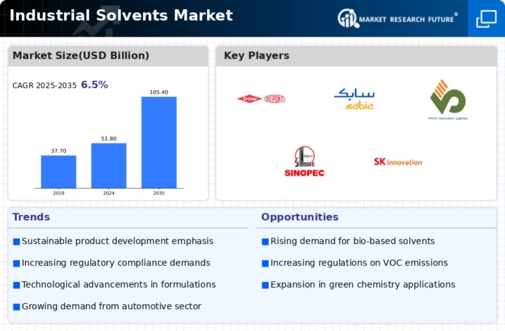Top Industry Leaders in the Industrial Solvents Market

Industrial Solvents Market
Industrial solvents, the workhorses of countless industries, play a vital role in processes ranging from paint thinning to pharmaceutical synthesis. From humble beginnings in coal tar distillation, the global solvent market has evolved into a multi-billion dollar battlefield, where established giants lock horns with agile innovators. Let's dive into the swirling currents of this dynamic market, exploring the key strategies, market share influencers, recent developments, and future trends.
Strategies Fueling Growth: Masters of the Mix
-
Innovation Prowess: BASF, the undisputed leader, dominates through continuous innovation. Their recent advances in bio-based and low-VOC (volatile organic compound) solvents cater to the growing demand for sustainable alternatives. -
Diversification Playbook: ExxonMobil leverages its vast petrochemical portfolio to offer a diverse range of solvent solutions, catering to various industries like paints, coatings, and adhesives. Their recent acquisition of a specialty solvent manufacturer strengthens their reach in niche markets. -
Cost-effective Efficiency: Chinese players like Zhejiang Satellite Chemical and Shenyang Chemical Group capitalize on lower production costs to offer competitive pricing. They cater to price-sensitive segments like cleaning and degreasing, steadily chipping away at market share.
Beyond the Titans: Factors Determining Market Share
-
Sustainability Imperative: The rising pressure for eco-friendly practices drives demand for bio-based and low-VOC solvents. Companies like Eastman Chemical are pioneers in this space, with their innovative solvent offerings finding favor in environmentally conscious industries. -
Regulatory Landscape: Stringent regulations on VOC emissions and hazardous waste disposal influence solvent choices. Players who offer compliant and safe alternatives gain an edge, as seen with Dow Chemical's focus on developing non-chlorinated solvents. -
Regional Nuances: Demand patterns vary across geographies. The booming construction industry in Asia Pacific fuels demand for architectural coatings, while stricter environmental regulations in Europe drive the adoption of water-based solvents. Understanding regional dynamics is crucial.
Key Players
- BASF SE (Germany)
- BP Plc (UK)
- Exxon Mobil Corporation (US)
- LyondellBasell Industries (The Netherlands)
- Royal Dutch Shell Plc (The Netherlands)
- Petroleo BrasileiroS.A (Brazil)
- DowDuPont (US)
- Total S.A. (France)
- SABIC (Saudi Arabia)
- Diacel Chemical Industries Ltd (Japan)
- Harmony Organics Pvt Ltd (India)
- Eternis Fine Chemicals (India)
- IGPL (India)
- Vinati Organics (India)
- Sinopec (China)
- SK Innovation (South Korea)
- LG Chemicals (Japan).
Recent Developments
In June 2023, Eastman Chemical Company announced the acquisition of the solvent business of Solvay. The acquisition is expected to be completed in the third quarter of 2023 and will make Eastman the third-largest solvent producer in the world.
In July 2023, Dow announced the launch of a new line of sustainable solvents. The new solvents are made from renewable feedstocks and are designed to reduce the environmental impact of industrial processes.
In August 2023, Shell announced the closure of its solvent production plant in the Netherlands. The closure is part of Shell's plan to exit the solvent business.
According to Biltrax Construction Data, in April 2022, India’s construction industry is expected to grow at a CAGR of 15.7% between 2016 and 2022, reaching USD 738.5 billion by the end of the forecast period. Solvent manufacturer suppliers should thus be ready for opportunities that would arise as a result of growth in the global scope.

